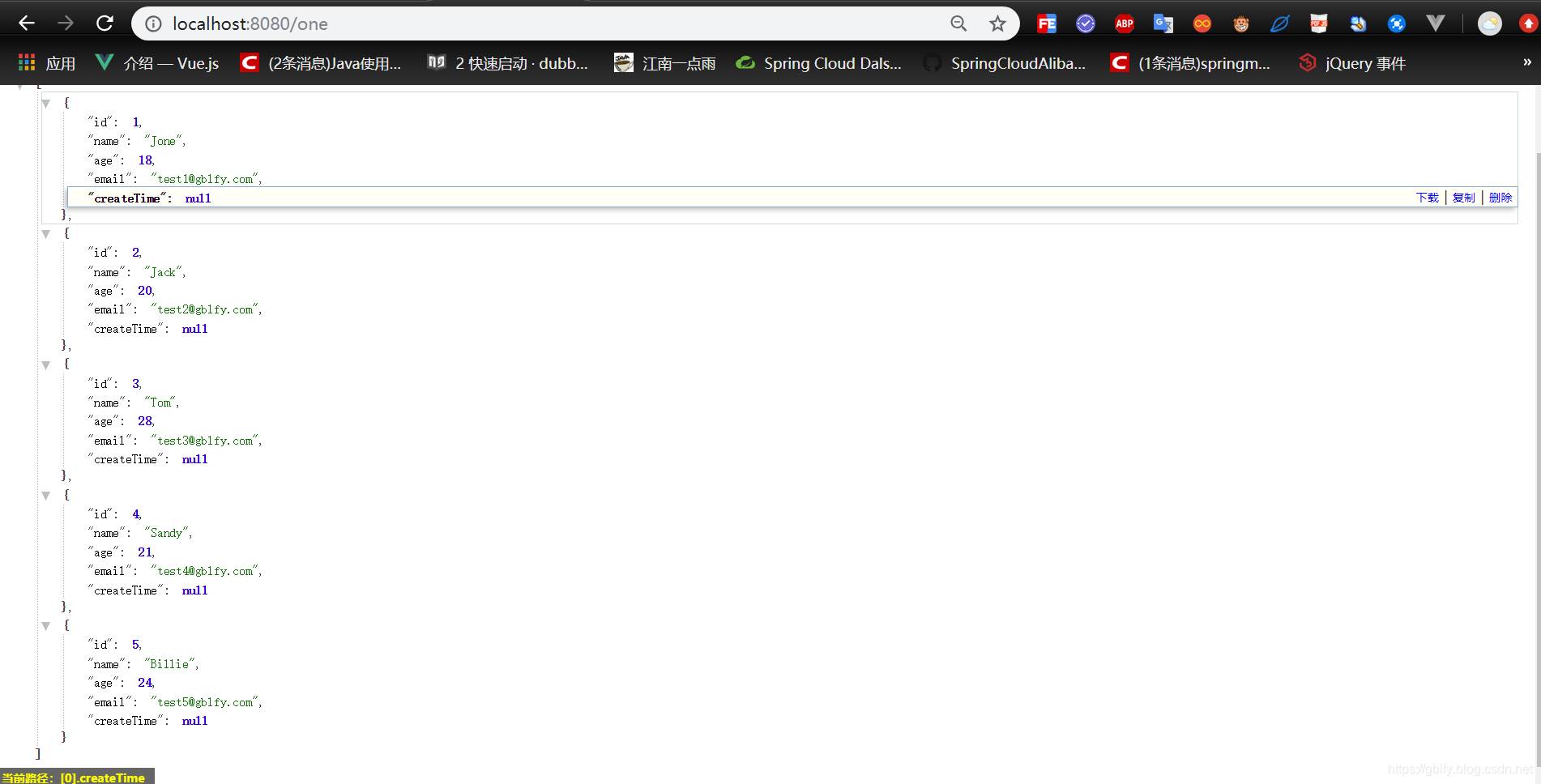pom.xml
<?xml version="1.0" encoding="UTF-8"?>
<project xmlns="http://maven.apache.org/POM/4.0.0" xmlns:xsi="http://www.w3.org/2001/XMLSchema-instance"xsi:schemaLocation="http://maven.apache.org/POM/4.0.0 https://maven.apache.org/xsd/maven-4.0.0.xsd"><modelVersion>4.0.0</modelVersion><parent><groupId>org.springframework.boot</groupId><artifactId>spring-boot-starter-parent</artifactId><version>2.1.11.RELEASE</version><relativePath/> <!-- lookup parent from repository --></parent><groupId>com.gblfy</groupId><artifactId>springboot-mybatis</artifactId><version>0.0.1-SNAPSHOT</version><name>springboot-mybatis</name><description>Demo project for Spring Boot</description><properties><java.version>1.8</java.version></properties><dependencies><!--SpringBoot mvc启动器--><dependency><groupId>org.springframework.boot</groupId><artifactId>spring-boot-starter-web</artifactId></dependency><!--Mysql数据库驱动--><dependency><groupId>mysql</groupId><artifactId>mysql-connector-java</artifactId><version>5.1.28</version><scope>runtime</scope></dependency><dependency><groupId>org.mybatis.spring.boot</groupId><artifactId>mybatis-spring-boot-starter</artifactId><version>2.0.1</version></dependency><!--lombok 简化java代码--><dependency><groupId>org.projectlombok</groupId><artifactId>lombok</artifactId><version>1.18.10</version></dependency><!--druid连接池--><dependency><groupId>com.alibaba</groupId><artifactId>druid-spring-boot-starter</artifactId><version>1.1.10</version></dependency><!--SpringBoot test 启动器--><dependency><groupId>org.springframework.boot</groupId><artifactId>spring-boot-starter-test</artifactId><scope>test</scope></dependency></dependencies><build><plugins><plugin><groupId>org.springframework.boot</groupId><artifactId>spring-boot-maven-plugin</artifactId></plugin></plugins><resources><resource><directory>src/main/java</directory><includes><include>**/*.xml</include></includes></resource><resource><directory>src/main/resources</directory></resource></resources></build></project>首先在 application.properties 中配置数据库基本信息,然后提供两个 DataSource 即可
spring.datasource.one.url=jdbc:mysql:///test01?useUnicode=true&characterEncoding=utf-8
spring.datasource.one.username=root
spring.datasource.one.password=root
spring.datasource.one.type=com.alibaba.druid.pool.DruidDataSourcespring.datasource.two.url=jdbc:mysql:///test02?useUnicode=true&characterEncoding=utf-8
spring.datasource.two.username=root
spring.datasource.two.password=root
spring.datasource.two.type=com.alibaba.druid.pool.DruidDataSource
然后再提供两个 DataSource,如下:
import com.alibaba.druid.spring.boot.autoconfigure.DruidDataSourceBuilder;
import org.springframework.boot.context.properties.ConfigurationProperties;
import org.springframework.context.annotation.Bean;
import org.springframework.context.annotation.Configuration;import javax.sql.DataSource;@Configuration
public class DataSourceConfig {@Bean@ConfigurationProperties(prefix = "spring.datasource.one")DataSource dsOne() {return DruidDataSourceBuilder.create().build();}@Bean@ConfigurationProperties(prefix = "spring.datasource.two")DataSource dsTwo() {return DruidDataSourceBuilder.create().build();}
}
MyBatis 配置
要提供两个 Bean,因此这里两个数据源我将在两个类中分开来配置,首先来看第一个数据源的配置:
mport org.apache.ibatis.session.SqlSessionFactory;
import org.mybatis.spring.SqlSessionFactoryBean;
import org.mybatis.spring.SqlSessionTemplate;
import org.mybatis.spring.annotation.MapperScan;
import org.springframework.context.annotation.Bean;
import org.springframework.context.annotation.Configuration;import javax.annotation.Resource;
import javax.sql.DataSource;@Configuration
@MapperScan(basePackages = "com.gblfy.springboot.mybatis.mapper1",sqlSessionFactoryRef = "sqlSessionFactory1",sqlSessionTemplateRef = "sqlSessionTemplate1")
public class MyBatisConfigOne {@Resource(name = "dsOne")DataSource dsOne;@BeanSqlSessionFactory sqlSessionFactory1() {SqlSessionFactory sessionFactory = null;try {SqlSessionFactoryBean bean = new SqlSessionFactoryBean();bean.setDataSource(dsOne);sessionFactory = bean.getObject();} catch (Exception e) {e.printStackTrace();}return sessionFactory;}@BeanSqlSessionTemplate sqlSessionTemplate1() {return new SqlSessionTemplate(sqlSessionFactory1());}
}创建 MyBatisConfigOne 类,首先指明该类是一个配置类,配置类中要扫描的包是 org.javaboy.mybatis.mapper1 ,即该包下的 Mapper 接口将操作 dsOne 中的数据,对应的 SqlSessionFactory 和 SqlSessionTemplate 分别是 sqlSessionFactory1 和 sqlSessionTemplate1,在 MyBatisConfigOne 内部,分别提供 SqlSessionFactory 和 SqlSessionTemplate 即可, SqlSessionFactory 根据 dsOne 创建,然后再根据创建好的SqlSessionFactory 创建一个 SqlSessionTemplate。
这里配置完成后,依据这个配置,再来配置第二个数据源即可:
import org.apache.ibatis.session.SqlSessionFactory;
import org.mybatis.spring.SqlSessionFactoryBean;
import org.mybatis.spring.SqlSessionTemplate;
import org.mybatis.spring.annotation.MapperScan;
import org.springframework.context.annotation.Bean;
import org.springframework.context.annotation.Configuration;import javax.annotation.Resource;
import javax.sql.DataSource;@Configuration
@MapperScan(basePackages = "com.gblfy.springboot.mybatis.mapper2",sqlSessionFactoryRef = "sqlSessionFactory2",sqlSessionTemplateRef = "sqlSessionTemplate2")
public class MyBatisConfigTwo {@Resource(name = "dsTwo")DataSource dsTwo;@BeanSqlSessionFactory sqlSessionFactory2() {SqlSessionFactory sessionFactory = null;try {SqlSessionFactoryBean bean = new SqlSessionFactoryBean();bean.setDataSource(dsTwo);sessionFactory = bean.getObject();} catch (Exception e) {e.printStackTrace();}return sessionFactory;}@BeanSqlSessionTemplate sqlSessionTemplate2() {return new SqlSessionTemplate(sqlSessionFactory2());}
}
好了,这样 MyBatis 多数据源基本上就配置好了,接下来只需要在 org.javaboy.mybatis.mapper1 和 org.javaboy.mybatis.mapper2 包中提供不同的 Mapper,Service 中注入不同的 Mapper 就可以操作不同的数据源。
com.gblfy.springboot.mybatis.mapper1中的 mapper:
import com.gblfy.springboot.mybatis.entity.User;import java.util.List;public interface UserMapperOne{List<User> getAllUser();
}
对应的 XML 文件:
<?xml version="1.0" encoding="UTF-8" ?>
<!DOCTYPE mapperPUBLIC "-//mybatis.org//DTD Mapper 3.0//EN""http://mybatis.org/dtd/mybatis-3-mapper.dtd">
<mapper namespace="com.gblfy.springboot.mybatis.mapper1.UserMapperOne"><select id="getAllUser" resultType="com.gblfy.springboot.mybatis.entity.User">select * from user;</select>
</mapper>com.gblfy.springboot.mybatis.mapper2中的 mapper:
import com.gblfy.springboot.mybatis.entity.User;import java.util.List;public interface UserMapper {List<User> getAllUser();
}
对应的 XML 文件:
<?xml version="1.0" encoding="UTF-8" ?>
<!DOCTYPE mapperPUBLIC "-//mybatis.org//DTD Mapper 3.0//EN""http://mybatis.org/dtd/mybatis-3-mapper.dtd">
<mapper namespace="com.gblfy.springboot.mybatis.mapper2.UserMapper"><select id="getAllUser" resultType="com.gblfy.springboot.mybatis.entity.User">select * from user;</select>
</mapper>
实体类:
import lombok.Data;import java.io.Serializable;
import java.time.LocalDateTime;@Data
public class User implements Serializable {//主键private Long id;//姓名private String name;//年龄private Integer age;//邮箱private String email;//创建时间private LocalDateTime createTime;
}
数据库脚本;
one
DROP TABLE IF EXISTS user;CREATE TABLE user
(id BIGINT(20) NOT NULL COMMENT '主键ID',name VARCHAR(30) NULL DEFAULT NULL COMMENT '姓名',age INT(11) NULL DEFAULT NULL COMMENT '年龄',email VARCHAR(50) NULL DEFAULT NULL COMMENT '邮箱',create_time DATETIME DEFAULT NULL COMMENT '创建时间',PRIMARY KEY (id)
);DELETE FROM user;INSERT INTO user (id, name, age, email, create_time) VALUES
(1, 'Jone', 18, 'test1@gblfy.com','2019-01-11 14:20:20'),
(2, 'Jack', 20, 'test2@gblfy.com','2019-02-05 11:12:22'),
(3, 'Tom', 28, 'test3@gblfy.com','2019-02-14 08:31:16'),
(4, 'Sandy', 21, 'test4@gblfy.com','2019-01-14 09:15:15'),
(5, 'Billie', 24, 'test5@gblfy.com','2019-01-14 09:48:16');two
DROP TABLE IF EXISTS user;CREATE TABLE user
(id BIGINT(20) NOT NULL COMMENT '主键ID',name VARCHAR(30) NULL DEFAULT NULL COMMENT '姓名',age INT(11) NULL DEFAULT NULL COMMENT '年龄',email VARCHAR(50) NULL DEFAULT NULL COMMENT '邮箱',create_time DATETIME DEFAULT NULL COMMENT '创建时间',PRIMARY KEY (id)
);DELETE FROM user;INSERT INTO user (id, name, age, email, create_time) VALUES
(1, 'Jone2', 18, 'test1@gblfy.com','2019-01-11 14:20:20'),
(2, 'Jack2', 20, 'test2@gblfy.com','2019-02-05 11:12:22'),
(3, 'Tom2', 28, 'test3@gblfy.com','2019-02-14 08:31:16'),
(4, 'Sandy2', 21, 'test4@gblfy.com','2019-01-14 09:15:15'),
(5, 'Billie2', 24, 'test5@gblfy.com','2019-01-14 09:48:16');写一个测试controller
import com.gblfy.springboot.mybatis.entity.User;
import com.gblfy.springboot.mybatis.mapper1.UserMapperOne;
import com.gblfy.springboot.mybatis.mapper2.UserMapper;
import org.springframework.beans.factory.annotation.Autowired;
import org.springframework.web.bind.annotation.GetMapping;
import org.springframework.web.bind.annotation.RestController;import java.util.List;@RestController
public class PageController {@Autowiredprivate UserMapperOne userMapperOne;@Autowiredprivate UserMapper userMapper;@GetMapping("/one")public List<User> getOneList() {return userMapperOne.getAllUser();}@GetMapping("/two")public List<User> getTwoList() {return userMapper.getAllUser();}
}
启动项目:
依次访问
http://localhost:8080/one
http://localhost:8080/two












——后台管理系统登录功能)








